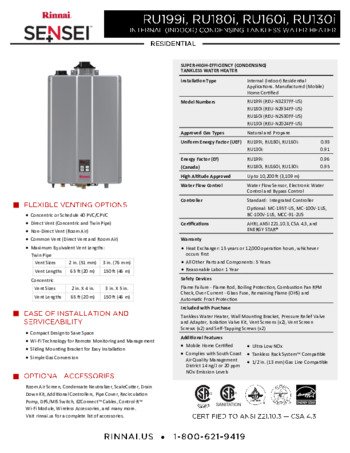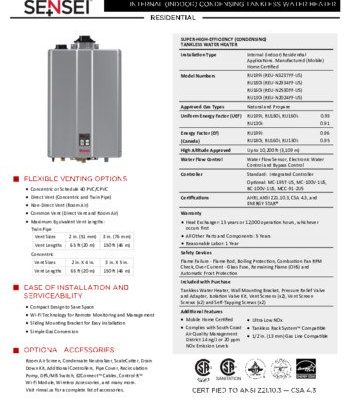
Honestly, understanding warranties can feel like reading a secret code. What’s covered? For how long? Are parts included or just repairs? Let me explain the ins and outs of the Rinnai water heaters warranty so you can feel confident about your purchase and know exactly what protection you have when you need it most.
Breaking Down the Basics: What Is a Rinnai Water Heater Warranty?
At its core, a warranty is a kind of promise from the manufacturer. Rinnai, a leading brand in tankless water heaters, backs their products with a warranty to protect you from unexpected failures. But here’s the thing—*not all warranties are created equal*, and understanding what’s covered can prevent frustration later on.
With Rinnai, their warranty typically covers defects in materials and workmanship. That means if certain parts of your water heater fail because of a manufacturing flaw, they’ll take care of repairs or replacements within the warranty period. It’s like having a safety net that catches you if something breaks out of the blue, not because of normal wear and tear or accidents.
You might be wondering, “Does this warranty cover everything?” Not exactly. Usually, things like damage from improper installation, neglect, or harsh environmental conditions aren’t covered. So, keeping your unit well-maintained and installed by a pro is key to staying in the warranty’s good books.
What Parts Does the Rinnai Warranty Cover?
Rinnai’s warranty is pretty clear about the parts it covers, which helps you know what to expect if something goes wrong. Here’s a breakdown of the main components typically included:
- Heat Exchanger: This is the heart of your tankless water heater. Rinnai usually offers a longer warranty for this part—sometimes up to 12 years—because it’s designed to last and is critical for heating your water efficiently.
- Other Components: Parts like the gas valve, burner assembly, and electronics often have shorter warranty periods, often around 5 years.
- Labor Costs: Some warranties include labor for repairs during a specific timeframe, but this can vary based on your location and installer.
Let me put it this way: The warranty is strongest where it counts most, like the heat exchanger, because that’s the part most costly and complicated to replace. But things like sensors or remotes might not have as long of coverage, so it’s good to check your specific warranty details.
What’s Not Covered?
Here’s the kicker: warranties don’t usually cover everyday wear, damage from hard water, or issues from messing around with the unit yourself. So if you try to reset or sync the unit without professional help and cause damage, that might not be covered.
How Long Does the Rinnai Warranty Last?
You might’ve heard that some warranties last “forever,” but that’s rarely true. With Rinnai, warranty lengths vary by model and part. Here’s a typical outline:
| Component | Warranty Length |
|---|---|
| Heat Exchanger | Up to 12 years |
| Parts (valve, burner, electronics) | 5 years |
| Labor | Typically 1 year (varies by region) |
One important note: The exact coverage and lengths depend on whether the heater is for residential or commercial use. Commercial warranties tend to be shorter because the unit’s working harder.
If you think about it, this warranty duration is like a peace-of-mind timer—while it’s ticking, you’re covered if a factory issue pops up. After that, it’s on you or your service plan to manage repairs or replacements.
How to Keep Your Warranty Valid: Installation and Maintenance
Here’s a story: A friend bought a Rinnai unit but installed it themselves to save money. When something went wrong, the warranty was void because the unit wasn’t installed by a licensed professional. Ouch.
Rinnai warranties almost always require professional installation. This isn’t just a policy—it’s to make sure your water heater is set up safely and performs well. If you skip this step, you risk losing warranty coverage.
Maintenance is another piece of the puzzle. Things like flushing the system to prevent scale buildup, checking filters, or troubleshooting basic errors should be done regularly. Many warranty agreements specify that failure to maintain the unit properly can void your coverage. So don’t ignore those reminders to flush your water heater or check the remote’s battery.
What About the Remote Control?
Rinnai water heaters often come with a remote controller. While it’s super handy to adjust temperature and settings, it usually has its own warranty limits. If your remote stops working, chances are it’s only covered for a year or two—and it’s a separate item from the main heater warranty.
Also, if you need to reset or pair your remote, those user actions don’t affect the warranty but messing with the wiring or internal parts might. So treat your remote like your TV remote: change batteries, reset when needed, but don’t tinker under the hood.
How to Make a Warranty Claim with Rinnai
Honestly, filing a warranty claim doesn’t have to be a headache if you know the steps. Here’s what you generally need to do:
- Gather Documentation: Keep your purchase receipt, installation paperwork, and warranty certificate handy. These are your proof that you have coverage.
- Contact the Installer or Rinnai: Sometimes, your original installer handles the claim. Other times, you’ll reach out directly to Rinnai’s customer service.
- Describe the Problem Clearly: Whether it’s a no-heat issue, error code, or a faulty part, give as many details as possible. If you have an error code from your unit, mention it—that helps speed things up.
- Schedule an Inspection: A certified technician may need to check your water heater to confirm the defect before repairs or replacements are approved.
Keep in mind that warranty service focuses on defects, not damage from your attempts at troubleshooting or resetting the unit yourself. If you’re unsure, it’s better to call a pro first.
Comparing Rinnai’s Warranty with Other Brands
If you’re shopping around, you might notice warranties vary a lot between brands. Here’s what makes Rinnai’s warranty stand out:
- Long Heat Exchanger Coverage: Many competitors offer 5–7 years, but Rinnai stretches up to 12 in some cases, which shows confidence in their tech.
- Clear Parts and Labor Coverage: Knowing the difference helps set expectations upfront—some brands mix or hide these details.
- Strict Installation Requirements: Rinnai’s solid requirement for professional installation is a double-edged sword—it protects you but requires extra upfront effort.
On the flip side, some universal or generic water heaters might offer easier installation or cheaper units but often come with shorter warranties or less comprehensive coverage.
Final Thoughts on the Rinnai Water Heaters Warranty
Here’s the takeaway: the Rinnai water heaters warranty is a smart safety net designed to cover manufacturing flaws, especially where it counts most—the heat exchanger and core parts. But like any warranty, it’s not magic. Following installation rules, doing routine maintenance, and using the remote properly keep you in good standing.
If something does go wrong, knowing how to navigate the claim process can save you time and frustration. Honestly, having a clear understanding of the Rinnai warranty means no surprises—just reliable hot water backed by a promise from a trusted brand.
So next time you glance at your water heater or fiddle with the remote, you can relax a little more knowing exactly what the warranty covers and how it protects you down the road.
